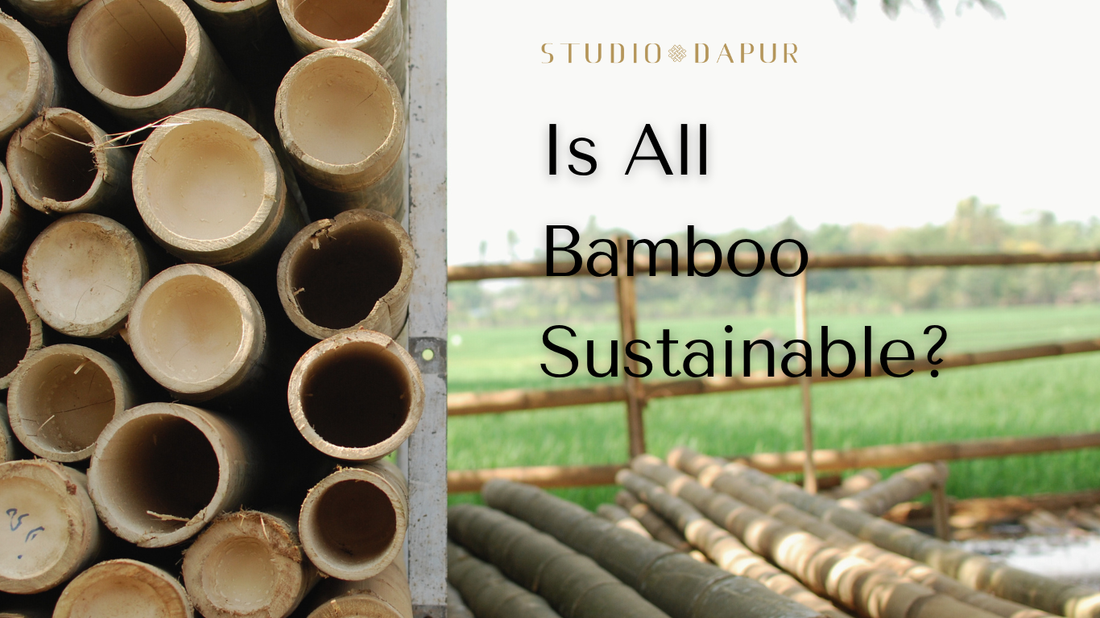In recent years, bamboo has gained global popularity as a sustainable material. It’s fast-growing, renewable, and biodegradable—making it a top choice for eco-conscious homes, designers, and brands. But at Studio Dapur, after nearly a decade working with bamboo crafts in West Java, we’ve learned that the story isn’t so simple.
We want to share what we've learned—not to point fingers, but to reflect honestly. Because we believe that sustainability isn't a claim. It's a practice. One we’re still learning, one step at a time.
Beyond the Buzzword: Rethinking “Sustainable Bamboo”
Yes, bamboo is a powerful natural material. But sustainability is more than what something is made of.
To truly be sustainable, a product must also ask:
• Where does the bamboo come from?
• How is it harvested and treated?
• Who is involved in the making?
• Are they being paid fairly, treated ethically, and supported long-term?
• What kind of systems are built around this craft?

At Studio Dapur, these are the kinds of questions that guide our work every day. Because a beautiful bamboo tray or lamp is not just an object—it’s the result of a long, often invisible chain of decisions, people, and processes.
From Commodity to Companion: A Deeper Relationship with Materials
When we first began working with bamboo, we met many people who changed the way we saw the material. One of them was a writer and literacy advocate, Bandung Mawardi, who reminded us that materials are not just resources—they are fellow beings in this world.
This thought stuck with us.
Because the more we worked with bamboo, the more we realized:
To treat it well means moving beyond extraction.
It means seeing bamboo not just as a commodity—but as a collaborator.
A material that teaches us rhythm, reciprocity, and resilience.
Sustainability Is a Spectrum—Not a Badge
We often think of sustainability as a yes or no question.
Is it eco-friendly?
Is it biodegradable?
Is it certified?
But the reality is more complex. Sustainability exists on a spectrum:
📉 Extractive — Harvesting without giving back. Exploiting labor. Disrupting ecosystems.
🟡 Neutral — Minimal harm, but minimal awareness or support for broader systems.
🌱 Regenerative — Restoring soil. Replanting bamboo. Uplifting makers. Designing with care.
At Studio Dapur, we know we are still on this journey. We’re not perfect—but we’re moving intentionally toward the regenerative side.
We:
• Collaborate directly with bamboo farmers in Galunggung
• Use sun-drying and minimize chemical treatments
• Favor woven techniques over board laminations
• Pay artisans fairly, based on skill and time
• Train young people in villages to carry the craft forward
And most importantly: we reflect, we listen, and we adjust.

Why It Matters—for All of Us
As more brands embrace natural materials, we believe it’s time for deeper conversations.
Not all bamboo products are created equal.
Not all sustainability claims reflect the full picture.
As consumers, designers, and fellow makers, we have the power—and the responsibility—to look beyond the label.
To ask: What is this product really made of? And who is it made for?
Because sustainability isn’t a status. It’s a direction.
One that includes both people and planet.
One that invites us to build—not just better products—but better relationships.

Let’s Keep the Conversation Going
If you're a maker, designer, buyer, or just someone who loves bamboo as much as we do—we’d love to hear your thoughts.
What questions are you asking in your own sustainability journey?
How do you balance craft, care, and commerce?
💬 Share your reflections in the comments, or email us at info@studiodapur.com.
Together, let’s keep growing—slowly, intentionally, and with care.

